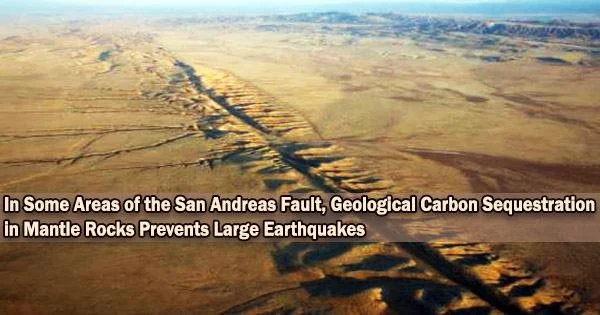The Californian San Andreas Fault is well known for producing powerful but occasional earthquakes. However, some sections of the San Andreas Fault (SAF) exhibit significant rates of continuous or episodic aseismic creep and often occurring small to moderate-sized earthquakes. That lessens the likelihood of significant earthquakes along those portions as the tectonic strain is discharged in a quasi-steady manner.
One underlying source of aseismic creep, according to experts, is ongoing geological carbon sequestration in mantle rocks in the creeping parts of the SAF, which spans around 150 kilometers between San Juan Bautista and Parkfield, California, as well as along many additional fault segments.
“Although there is no consensus regarding the underlying cause of aseismic creep, aqueous fluids, and mechanically weak minerals appear to play a central role,” researchers say in a new paper, “Carbonation of serpentinite in creeping faults of California,” published in Geophysical Research Letters.
The new study integrates field observations and thermodynamic modeling “to examine possible relationships between the occurrence of serpentinite, silica-carbonate rock, and CO2-rich aqueous fluids in creeping faults of California,” the paper states.
“Our models predict that carbonation of serpentinite leads to the formation of talc and magnesite, followed by silica-carbonate rock. While abundant exposures of silica-carbonate rock indicate complete carbonation, serpentinite-hosted CO2-rich spring fluids are strongly supersaturated with talc at elevated temperatures. Hence, carbonation of serpentinite is likely ongoing in parts of the San Andres Fault system and operates in conjunction with other modes of talc formation that may further enhance the potential for aseismic creep, thereby limiting the potential for large earthquakes.”
The paper indicates that because wet talc is a mechanically weak mineral, “its formation through carbonation promotes tectonic movements without large earthquakes.”
The researchers acknowledged a number of potential underlying mechanisms causing aseismic creep in the SAF and also noted that an additional or different mechanism the carbonation of serpentinite is required to account for the full extent of the creep because aseismic creep rates are noticeably higher in some parts of the SAF system.
The addition of CO2 to mantle rocks which is the mineral carbonation or carbon sequestration process had not previously been investigated in the context of earthquake formation or the natural prevention of earthquakes. Using basic geological constraints, our study showed where these carbonate-altered mantle rocks are and where there are springs along the fault line in California that are enriched in CO2. It turned out that when you plot the occurrence and distribution of these rock types and the occurrence of CO2-rich springs in California, they all line up along the San Andreas Fault in creeping sections of the fault where you don’t have major earthquakes.
Frieder Klein
Researchers thought that rock might be to blame for the lubrication because fluids are almost everywhere along the SAF yet only some parts of the fault are lubricated. Some earlier investigations have hypothesized that the lubricant might be talc, a delicate and slick substance frequently found in baby powder.
A well-established mechanism for forming talc is by adding silica to mantle rocks. The researchers in this case, however, concentrated on another method of talc formation: adding CO2 to mantle rocks to create soapstone.
“The addition of CO2 to mantle rocks which is the mineral carbonation or carbon sequestration process had not previously been investigated in the context of earthquake formation or the natural prevention of earthquakes. Using basic geological constraints, our study showed where these carbonate-altered mantle rocks are and where there are springs along the fault line in California that are enriched in CO2. It turned out that when you plot the occurrence and distribution of these rock types and the occurrence of CO2-rich springs in California, they all line up along the San Andreas Fault in creeping sections of the fault where you don’t have major earthquakes,” said Frieder Klein, lead author of the journal article.
According to Klein, an associate scientist in the Woods Hole Oceanographic Institution’s Marine Chemistry and Geochemistry Department, carbonation is essentially a rock’s absorption of CO2. The locations of carbonate-altered rocks and CO2-rich springs were plotted using Google Earth and pre-existing U.S. Geological Survey records, according to Klein.
“The geological evidence suggests that this mineral carbonation process is taking place and that talc is an intermediary reaction product of that process,” Klein said. Although researchers did not find soapstone on mantle rock outcrops, results from theoretical models “strongly suggest that carbonation is an ongoing process and that soapstone indeed could form in the SAF at depth,” the paper notes.
These theoretical models “suggest that carbon sequestration with the SAF is taking place today and that the process is actively helping to lubricate the fault and minimize strong earthquakes in the creeping portions of the SAF,” Klein said.
The paper also notes that this mechanism may also be present in other fault systems. “Because CO2-rich aqueous fluids and ultramafic rocks are particularly common in young orogenic belts and subduction zones, the formation of talc via mineral carbonation may play a critical role in controlling the seismic behavior of major tectonic faults around the world.”
“Our study allows us to better understand the fundamental processes that are taking place within fault zones where these ingredients are present and allows us to better understand the seismic behavior of these faults, some of which are in densely populated areas and some of which are in lightly populated or oceanic settings,” Klein said.
This work was supported by grants from the National Science Foundation.





